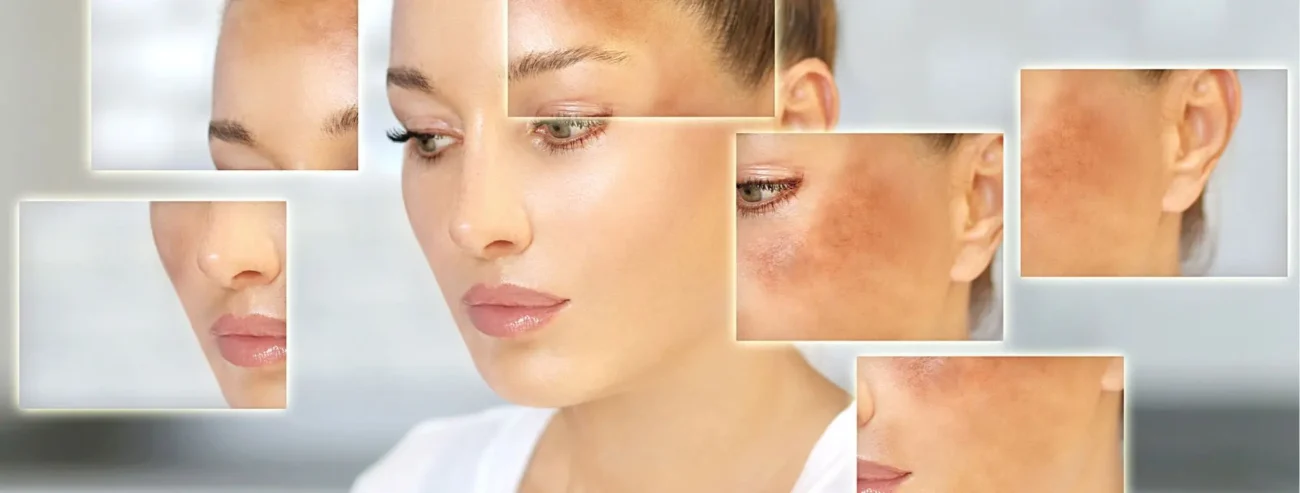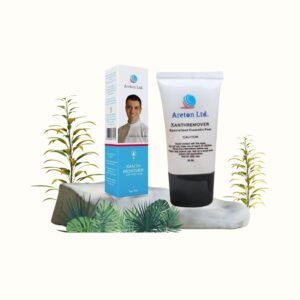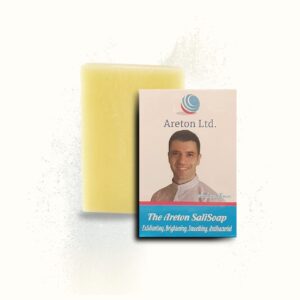What is Hyperpigmentation?
Hyperpigmentation is a condition that causes patches of skin to become darker than the normal surrounding skin. It occurs when there is an excess production of melanin, which is the pigment that gives skin its color.
Hyperpigmentation can be caused by a variety of factors, like sun exposure, hormonal changes, or skin damage and inflammation. When the skin produces more melanin, it results in darkened patches on the skin that can appear as spots or blotches. These darker areas are known as hyperpigmentation.
While hyperpigmentation is usually harmless, some people seek treatment for cosmetic reasons or if it is causing distress. The most common areas for hyperpigmentation to occur are the face, neck, hands, and legs. Treatments can help reduce the appearance of hyperpigmentation, but it may take time to see results. Preventative measures like sunscreen are important to stop hyperpigmentation from developing or getting worse.
Types of Hyperpigmentation
Hyperpigmentation can manifest in different forms on the skin. Some of the most common types include:
Melasma
Melasma causes brown or grayish patches on the face, especially on the cheeks, nose, forehead and upper lip. It is more common in women and those with darker skin tones. Melasma is often triggered by sun exposure or hormonal changes like pregnancy.
Post-inflammatory hyperpigmentation
This type of hyperpigmentation appears as spots or patches in areas that have experienced inflammation or injury. It is especially common after acne, eczema, psoriasis, or an injury. The skin produces excess melanin as part of the healing process.
Solar lentigines (age spots)
Solar lentigines are flat, tan or brown spots that appear on sun-exposed areas like the face, hands, arms, and chest. They are associated with aging and cumulative sun exposure over many years.
Freckles
Freckles are small, flat brown spots. They often emerge in childhood and adolescence on sun-exposed areas and tend to fade with age. Freckles are genetic and associated with fair skin tones.
Periorbital hyperpigmentation
This refers to dark circles or shadows that appear around the eyes. It can be caused by genetics, sun damage, or increased pigment production. The skin around the eyes is thin and delicate.
Acanthosis nigricans
This condition causes velvety, dark patches on body folds and creases like the armpits, groin, and neck. It is associated with obesity, insulin resistance, and diabetes. The discoloration is caused by skin cell growth.
Causes of Hyperpigmentation
Hyperpigmentation can occur for various reasons. Some of the most common causes include:
Sun exposure/UV radiation: One of the biggest culprits of hyperpigmentation is sun exposure and UV radiation. The sun’s UV rays can damage skin cells and stimulate melanin production, leading to darker patches on the skin. Both short-term sun exposure and cumulative sun damage over time can cause hyperpigmentation.
Inflammation from acne, eczema, etc.: Inflammatory skin conditions like acne, eczema, and psoriasis can also trigger hyperpigmentation. The inflammation process promotes melanin production, often leaving behind dark spots or patches after the inflammation subsides. This is called post-inflammatory hyperpigmentation.
Hormones: Hormonal changes and fluctuations can lead to hyperpigmentation for some people. This includes hormonal changes during pregnancy, with birth control pills, or those associated with endocrine disorders. The hormones stimulate melanin synthesis, causing darker skin patches.
Genetics: Those with naturally darker skin tones are at greater risk for hyperpigmentation since their skin naturally produces more melanin. Genetic conditions like melasma also predispose people to hyperpigmentation.
Aging: As skin ages, the melanin-producing cells can become damaged and cluster together in certain areas. This leads to age spots or solar lentigines, a form of hyperpigmentation.
Skin disorders: Certain skin disorders like acanthosis nigricans cause velvety hyperpigmented patches, especially around body folds. This is related to underlying health conditions like diabetes or insulin resistance.
Medications: Some medications like certain antibiotics, antimalarials, and chemotherapy drugs can cause hyperpigmentation as a side effect. The medications can increase melanin production.
Hyperpigmentation Risk Factors
Certain factors can increase your risk of developing hyperpigmentation. These include:
Darker skin tones – Those with darker skin, especially skin types IV-VI, are more prone to hyperpigmentation as they have more melanin in their skin naturally. Higher amounts of melanin leads to more potential for overproduction.
Hormonal changes – Fluctuations in hormones, especially during puberty, pregnancy, and menopause, can trigger excess melanin production. Estrogen and progesterone levels directly impact melanin synthesis.
Geographic location/UV exposure – Areas with year-round sun exposure have higher rates of hyperpigmentation. UV radiation stimulates melanin production as a protective response. Those living closer to the equator are at increased risk.
Skin inflammation/trauma – Inflammatory skin conditions like acne and eczema can cause post-inflammatory hyperpigmentation after the inflammation resolves. Any trauma to the skin, like cuts, burns, or rashes, can also trigger hyperpigmentation during the healing process.
Aging – As skin ages, melanin synthesis slows while melanin accumulates in clusters. Age spots and solar lentigines are examples of hyperpigmentation due to aging skin.

Diagnosing Hyperpigmentation
Diagnosing hyperpigmentation typically begins with a medical history and physical exam. The doctor will ask about symptoms, when they started, and possible triggers. They will examine the affected areas of skin and distinguish between different types of hyperpigmentation.
In some cases, a skin biopsy may be done to confirm the diagnosis. This involves numbing the area, taking a small sample of skin, and examining it under a microscope. A biopsy can help rule out other skin conditions like melanoma.
The characteristics of the hyperpigmented patches like size, shape, color, and texture provide clues to the cause. Doctors may also use a Wood’s lamp, which emits UVA light, to examine the skin more closely. This helps determine how deep in the skin the pigment changes are occurring.
Overall, a combination of medical history, physical exam, and sometimes biopsy allows dermatologists to accurately diagnose different forms of hyperpigmentation.
Preventing Hyperpigmentation
There are several ways to help prevent hyperpigmentation from developing or worsening:
Use Sunscreen Daily: Applying broad spectrum sunscreen with an SPF 30 or higher every day is crucial. Sun exposure is one of the main triggers for increased melanin production and hyperpigmentation. Using sunscreen helps block UV radiation that stimulates melanocytes. Reapply sunscreen every 2 hours when outdoors.
Wear Protective Clothing: Covering up exposed skin helps limit sun damage. Wear wide-brimmed hats, tightly woven long-sleeved shirts, pants, and sunglasses when out in the sun. UV-blocking clothes add another layer of protection.
Avoid Irritants: Chemical irritants like hydroquinone or retinoids can worsen hyperpigmentation for some people. Avoid using new products that cause redness, itching, burning or other irritation on hyperpigmented areas. Stop using any products that increase irritation.
Control Inflammation: Inflammation can trigger melanocyte activity and more melanin production. Using topical anti-inflammatory creams and avoiding inflammation-causing activities like picking at the skin can prevent hyperpigmentation from worsening. Managing underlying health conditions that cause inflammation is also helpful.
Treating Hyperpigmentation
There are several effective medical treatments for hyperpigmentation:
Hydroquinone
Hydroquinone is a topical bleaching agent that inhibits tyrosinase, the enzyme involved in melanin production. It comes in creams, gels, and lotions, in concentrations of 2-4%. Higher concentrations are more effective but also increase the risk of side effects like irritation. Hydroquinone should not be used for more than 3-6 months at a time.
Retinoids
Retinoids like tretinoin and tazarotene can help treat hyperpigmentation by increasing cell turnover. They are often combined with hydroquinone for greater efficacy. Retinoids can cause dryness, peeling, redness and irritation.
Azelaic Acid
Azelaic acid is a naturally occurring acid that works by killing abnormal melanocytes. It comes as a cream, gel, or foam. Azelaic acid has antibacterial properties so it helps clear acne as well. It can cause skin irritation, stinging and redness.
Kojic Acid
Kojic acid derived from mushrooms is a good alternative to hydroquinone. It works by blocking tyrosinase. Kojic acid is available in creams and serums, either alone or combined with other actives. It can be irritating, especially in higher concentrations.
Chemical Peels
Chemical peels with glycolic acid or trichloroacetic acid can help peel off pigmented skin layers to reveal fresh skin. They should be done by a dermatologist. Chemical peels can cause temporary redness, irritation, swelling and peeling.
Laser Therapy
Laser therapy like Q-switched lasers target pigmented cells without damaging surrounding skin. Multiple sessions are usually required. Laser therapy can be expensive but provides long-lasting results for many. Risks include pain, blistering, scarring and infection.
Home Remedies for Hyperpigmentation
There are several natural home remedies that can help reduce the appearance of hyperpigmentation:
Sunscreen
Using sunscreen daily is critical for preventing further darkening of hyperpigmented areas. Look for a broad spectrum sunscreen with an SPF of at least 30. Reapply sunscreen every 2 hours when outdoors.
Vitamin C
Vitamin C is an antioxidant that can inhibit melanin production. Look for serums containing 10-20% vitamin C such as L-ascorbic acid. Apply it directly to pigmented areas in the morning.
Aloe Vera
The antioxidants in aloe vera help repair skin damage. Apply aloe vera gel directly to hyperpigmented areas and leave it on for 30 minutes before rinsing. Doing this daily can lighten pigmentation over time.
Licorice Extract
Licorice extract contains liquiritin and glabridin which help brighten skin. Look for licorice root extracts in serums or creams. Apply to the affected area twice daily.
Green Tea
Green tea is rich in antioxidants called catechins that reduce pigmentation. Brew some green tea, let it cool, and apply with a cotton pad directly to pigmented skin twice daily.
Exfoliation
Gently exfoliating 2-3 times per week with a scrub, peel, or brush can help speed up skin cell turnover and fade hyperpigmentation faster. Be sure not to over-exfoliate which can cause irritation.
When to See a Doctor
You should see your doctor if:
The hyperpigmentation worsens or spreads to other areas of your skin. This could indicate an underlying condition causing the pigmentation changes.
The hyperpigmentation severely affects your physical appearance or self-esteem. Your doctor can refer you to a dermatologist who specializes in treating pigmentation disorders.
You have any moles or spots that change shape, color or size. This could be a sign of melanoma, a dangerous type of skin cancer. Melanoma requires prompt medical evaluation and treatment.
See your doctor promptly if you have any concerns about new or changing skin growths or pigmentation. Early evaluation is key, especially if melanoma is suspected. With appropriate treatment, many causes of hyperpigmentation can be managed. Your doctor can help determine if your pigmentation changes require medical care.
Summary/Conclusion
Hyperpigmentation is a condition that causes patches of skin to become darker than the normal surrounding skin. The main types of hyperpigmentation are melasma, post-inflammatory hyperpigmentation, sun spots, and age spots. Hyperpigmentation can be caused by various factors like sun exposure, hormonal changes, skin injuries, inflammation, and genetics.
While hyperpigmentation is usually harmless, it can be distressing for some people. Several treatment options are available depending on the cause and type of hyperpigmentation. Topical creams with ingredients like hydroquinone, azelaic acid, retinoids, and vitamin C can help reduce pigmentation. Procedures like chemical peels, microdermabrasion, and laser therapy may also be effective.
To prevent hyperpigmentation, it’s important to limit sun exposure by wearing sunscreen and protective clothing outdoors. Avoid picking at the skin to prevent post-inflammatory hyperpigmentation. See a dermatologist if hyperpigmentation is causing significant distress or not responding to over-the-counter treatments.
For more information on hyperpigmentation, consult reputable sources like the American Academy of Dermatology website. With proper skincare and treatment if necessary, it is possible to manage and improve the appearance of hyperpigmented skin.
-
 Rated 0 out of 5¡A la Venta!Add to basket
Rated 0 out of 5¡A la Venta!Add to basket$50.99Original price was: $50.99.$39.99Current price is: $39.99. -
 Rated 0 out of 5¡A la Venta!Add to basket
Rated 0 out of 5¡A la Venta!Add to basket$10.00Original price was: $10.00.$5.99Current price is: $5.99. -
 Rated 0 out of 5¡A la Venta!Add to basket
Rated 0 out of 5¡A la Venta!Add to basket$10.00Original price was: $10.00.$5.99Current price is: $5.99. -
 Rated 0 out of 5¡A la Venta!Add to basket
Rated 0 out of 5¡A la Venta!Add to basket$10.00Original price was: $10.00.$5.99Current price is: $5.99.


